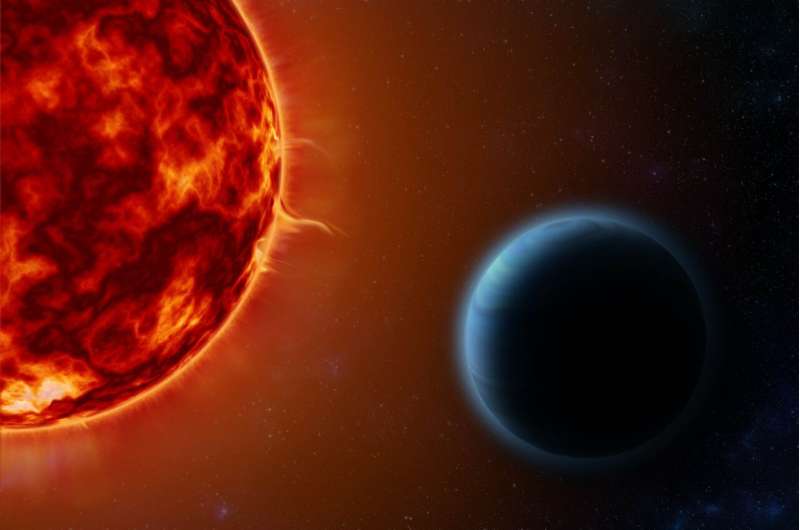Chemical element potassium detected in an exoplanet atmosphere

A team of astronomers led by AIP Ph.D. student Engin Keles detected the chemical element potassium in the atmosphere of an exoplanet, for the first time with overwhelming significance and applying high-resolution spectroscopy. The Potsdam Echelle Polarimetric and Spectroscopic Instrument (PEPSI) at the Large Binocular Telescope (LBT) in Arizona was used to study the atmosphere on the Jupiter-like exoplanet HD189733b.
Ever since the earliest theoretical predictions 20 years ago, the chemical elements potassium and sodium were expected to be detectable in atmospheres of "hot Jupiters," gaseous planets with temperatures of a few thousand Kelvin that orbit closely around far-away stars. While sodium was detected with high resolution observations already early on, potassium was not, which created a puzzle for atmospheric chemistry and physics.
The elements can be discovered by analyzing the home star's spectrum of light when the planet passes in front of it as seen from Earth. Different elements cause specific absorption signals in the spectrum, dark lines, that hint at the chemical composition of the atmosphere. However, the presence of clouds in hot Jupiter atmospheres strongly weakens any spectral absorption features and thus makes them very hard to detect. Even for HD189733b, the best studied hot Jupiter, so far scientists only possessed a very vague and imprecise knowledge of the potassium absorption. The exoplanet, 64 light years away and about the size of Jupiter, orbits its home star—a red giant—in 53 hours and is 30 times closer to it than the Earth to the Sun. It needed the light gathering capability of the 2x8,4m LBT and the high spectral resolution of PEPSI to definitely measure potassium for the first time at high resolution in atmospheric layers above the clouds. With these new measurements, researchers can now compare the absorption signals of potassium and sodium and thus learn more about processes such as condensation or photo- ionization in these exoplanet atmospheres.
The technique that was applied for this study at LBT is called transmission spectroscopy. It requires that the exoplanet transits in front of the host star. "We took a time series of light spectra during the transit and compared the absorption depth," says the lead author of the study, Engin Keles, Ph.D. student at AIP in the group Stellar Physics and Exoplanets. "During transit, we then detected the potassium signature, which disappeared before and after transit as expected, which indicates that the absorption is induced by the planetary atmosphere." Investigations by other teams already attempted to detect potassium on the same exoplanet, however, either nothing was found or what was found was too weak to be statistically significant. Until now there has been no significant detection of potassium in high resolution observations for any exoplanet.
"Our observations clearly made the breakthrough" emphasizes project co-leader Dr. Matthias Mallonn, who is seconded by PEPSI's principal investigator Prof. Klaus Strassmeier: "PEPSI is well suited for this task because of its high spectral resolution that allows collecting more photons per pixel from very narrow spectral lines than any other telescope-spectrograph combination." "Both as a spectrograph and as a spectropolarimeter, PEPSI has already made significant contributions to stellar physics," adds Christian Veillet, LBT Observatory's Director. "This strong detection of potassium in the atmosphere of an exoplanet establishes PEPSI as an amazing tool for exoplanet characterization as well as a unique asset for the members of the LBT community."
More information: Engin Keles et al. The potassium absorption on HD189733b and HD209458b, Monthly Notices of the Royal Astronomical Society: Letters (2019). DOI: 10.1093/mnrasl/slz123
Journal information: Monthly Notices of the Royal Astronomical Society Letters
Provided by Leibniz-Institut für Astrophysik Potsdam



















